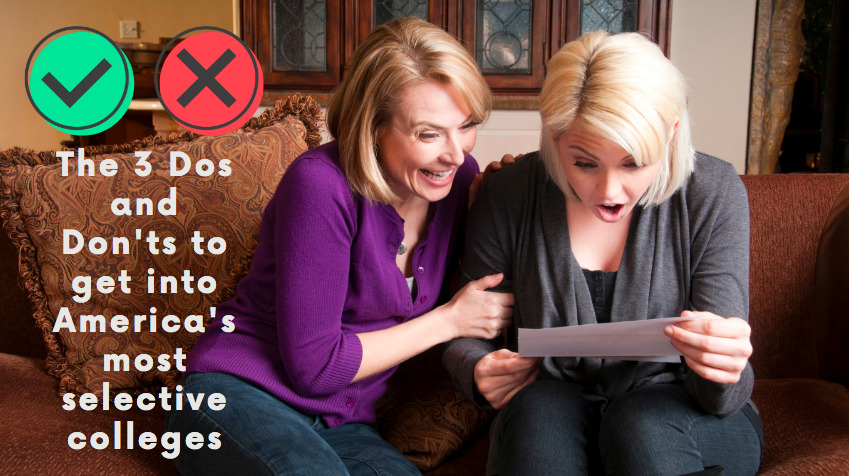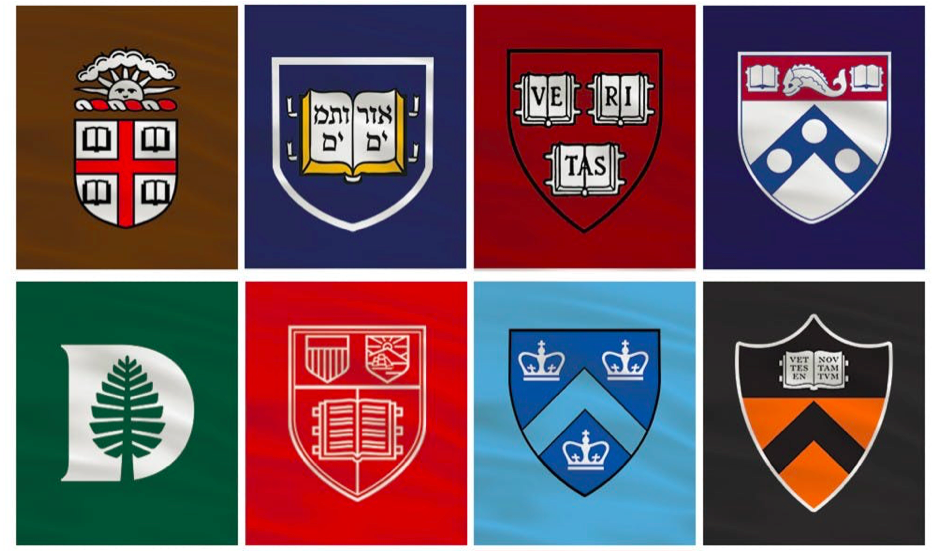
There is so much misinformation out there regarding how to get into America’s most selective colleges, and sadly, a lot of it comes from high school counselors themselves.
Luckily, by reading on, you will get some of the best advice that many high school-based counselors are unable or unwilling to give their students.
Here are the 3 Dos and 3 Don’ts to help you get accepted into America’s most selective colleges:
1. Don’t be well-rounded. Do be well-lopsided.
Why well-rounded students get skipped
It almost doesn’t seem fair. You work hard throughout high school, joining clubs and sports teams, focusing on getting good grades, trying to be the most well-rounded student you can possibly be – and then comes time to start applying to colleges.
For years, you have dreamed of attending some of the more selective colleges in the nation: Duke, UC Berkeley, Michigan, perhaps some of the Ivies, like Harvard, Yale, or Princeton. You have put in the work, built the resume.
Applying to college can be an exciting yet stressful time in a high-schooler’s life. After all, this is what all the hard work was about. This is why you packed your schedule with extracurriculars. This is why you stayed up late studying for those exams.
But before you begin submitting those applications, there is something important you should know: college admissions officers are not looking for well-rounded students.
On the surface, that might not make much sense.
Let’s take a deeper dive into why well-rounded students get passed over and what admissions officers are really looking for in high school applicants.
Well-rounded student vs. well-rounded class
If you are a well-rounded student, don’t take this personally. But consider this a fair warning: college admissions officers are not looking for well-rounded students.
If you’re going down the path of well-roundedness and you have your eyes set on a top college, you need a change of course – before it’s too late.
Many students might find this confusing. After all, you’ve been told time and time again by teachers, parents, and counselors that you need to join a wide variety of clubs, try out for some sports teams, volunteer, get involved however possible.
“If I can show colleges that I can do a little bit of everything, then surely, I’ll set myself apart from the rest of the competition.”
Unfortunately, this sort of thinking couldn’t be further from the truth.
The reality is that admissions officers are not looking for well-rounded students. They are trying to put together a well-rounded class. The mistake that so many college applicants make is trying to be a jack of all trades, which inevitably leads to being a master of none.
With this in mind, you likely only have one question to ask: then what does it take to get accepted to highly selective colleges?
What admissions officers are looking for
The simple truth is that if you want to go to a top college, you can’t just blend in with the crowd—you have to stand out among the other applicants. That may seem like straightforward advice, but it’s far more difficult to put into practice.
Virtually everyone applying to the Ivy League has good grades. Many played sports. Many were involved with the same types of activities and organizations: choir, National Honor Society, and Student Council. On their own, none of these activities will make your application stand out to top colleges.
To college admissions officers, you must be able to prove that you are an applicant who deserves their attention, interest, and ultimately, consideration.
And with many top colleges only spending eight minutes or fewer on any given application, you need to spark their interest – fast.
Brainstorm what sets you apart, what differentiates you from the mounds of well-rounded students who also want one of the select few spots in the upcoming freshman class.
In one of his popular blog posts, Allen Cheng, a Harvard alumnus and co-founder of a college test prep company, notes that there are two things that elite college admissions officers are looking for from applicants; they seek those “who are going to accomplish world-changing things” and those “who are going to contribute positively to their communities while in college and help other students accomplish great things as well.”
Understandably, neither one of those traits are a walk in the park. But with your application, it is your job not to demonstrate how much of a well-rounded student you are, but rather to demonstrate how you are the right applicant to accomplish such remarkable things in the future.
At the end of the day, being a well-rounded student may lead to modest successes in high school, but when it comes to applying to the nation’s most sought-after colleges, be sure you are demonstrating what sets you apart. The members of the next generation who will change the world are almost certainly not well-rounded – they are masters of their trades.
2. Don’t dabble. Do focus.
Why the best college applicants are the most focused
Focus is key.
You’ve already learned that the first key to acceptance into schools like Harvard, MIT, and Stanford is abandoning the image of a well-rounded student, and instead highlighting what sets you apart, and what makes you the type of student who will go on to change the world someday.
We know that alumni of many top colleges are often well-known for their astonishing contributions to the world – Nobel laureates, Pulitzer Prize winners, Olympic medalists…But long before that, while they’re still back in high school, working hard with their minds set on attending one of those schools, how do admissions officers pick them out? What is it that sets these future leaders apart in high school – and on their applications – that so clearly speaks to what their long-term success will look like?
The secret is that the best college applicants are also the most focused candidates. Let’s dive a little deeper into what it means to be hyper-focused and what sets those students apart from the rest of the crowd.
The best college applicants don’t dabble
Being a well-rounded student is usually just another way of saying that the student dabbles in a multitude of activities, often without mastering any of them.
Students who find they have strived their entire high school careers to get involved with as many activities as possible to “round out their resume” should heed this advice. The truth is that if you are preparing to send a competitive application to top colleges, you need to hone in on a select few skills or pursuits. That’s where you should be focusing from here on out.
All those other activities, the ones you are doing half-heartedly or just for a participation trophy – those are simply time-wasters. Take some time to identify those activities now and abandon them.
This is not to say that there was no value in dabbling at a younger age. After all, you need some time to develop your skill sets and identify where your talents lie. But as you progress through high school, and especially as you prepare for college, you should be narrowing your focus and eliminating the activities that simply serve as distractions.
The best college applicants are hyper-focused
Take a moment to think about the people who are the best at what they do in the world. Think about Facebook founder Mark Zuckerberg and NBA superstar LeBron James. No one talks about Zuckerberg’s ability to play basketball, and no one discusses James’s web development skills. You know why? Because those things don’t matter. It’s not what makes them great. What matters are the skill sets each of them uniquely garners that make them truly great.
It’s a safe bet to say that these top-performers cultivated their skills through focused attention and work.
That’s the same type of hyper-focus high school students should use to become the most competitive college applicants.
Focus, as defined in a Psychology Today article, “involves the ability to pay attention to things that will help avoid distractions that will hurt your work efforts.”
It’s really as simple as that.
Discard the activities that are time-wasters and spend your time and energy on your true strengths. Some might call this your “spike,” “pointiness,” personal brand, or elevator pitch – whatever the term, it’s the overall theme that you’re trying to convey to admissions officers.
So what does it look like to harness the type of hyper-focus that will lead to admissions success? There are several tangible steps you can take.
One of the most significant leaps you can make is to eliminate unhelpful extracurriculars and instead focus on the ones that highlight your best skills. So many high schoolers are encouraged to take up as many extracurriculars as they can – sports, music, clubs, volunteer work. But, admissions officers are going to look at this list and judge you based on whether or not they require any special knowledge or skills to succeed, or whether or not you are a leader or just another run-of-the-mill teammate or club member.
If anyone could do it just by dedicating some time, it doesn’t stand out on applications.
Consider also auditing your free time outside of schoolwork and extracurriculars, and determine if you’re truly spending it wisely. We live fast-paced lives, and, of course, high school students have social lives to live. The advice here is not to completely disregard your social life or the small pleasures of everyday life.
Instead, it’s to be conscious of where you’re spending your time, and to refocus when you find yourselves straying from your long-term goals.
This type of hyper-focus is what differentiates average applicants from the “must-admits.”
3. Don’t give up. Do be gritty.
If you want to successfully compete for a seat at a top college, you need a certain mindset. After all, years of dedication, hard work and high performance culminate with these college applications.
The college application process, and all the work that leads up to it, is enough to burn out many students. But the most successful college applicants have one other thing in common: they are gritty.
Why gritty students have the best chance for admission
Angela Duckworth is a leading researcher who, literally, wrote the book on grit and its impact on success, called Grit: The Power of Passion and Perseverance. She defines the trait as “passion and perseverance of very long-term goals.”
According to Duckworth’s research, the most successful students are not necessarily those with the highest IQ or exam scores. Rather, she notes in her book, “the highly successful had a kind of ferocious determination that played out in two ways. First, these exemplars were unusually resilient and hardworking. Second, they knew in a very, very deep way what it was they wanted. They not only had determination, but they also had direction.”
Duckworth is someone worth listening to when it comes to grit’s role in being accepted into elite colleges, herself having earned degrees from Harvard, the University of Pennsylvania, and the University of Oxford. Her research uses grit as the greatest predictor of long-term success, rather than talent.
Becoming a grittier person will not happen overnight. It’s a trait that you develop in the long run, with benefits that you reap lifelong.
This is to say, students who are gritty and can clearly demonstrate that grit on their applications have the best chance for admission to top colleges. There is a long list of talented applicants on the desks of Ivy League admissions officers. But those whose story is one of grittiness — a relentless pursuit of a select few strengths and overcoming of obstacles — those applicants consistently dominate the admissions game.



 So much of what you read, watch, or hear in the media is there to make you feel like it’s impossible to get into Brown, Columbia, Cornell, Dartmouth, Harvard, Penn, Princeton, and Yale without cheating your way in or using some unsavory connection to worm your way in.
So much of what you read, watch, or hear in the media is there to make you feel like it’s impossible to get into Brown, Columbia, Cornell, Dartmouth, Harvard, Penn, Princeton, and Yale without cheating your way in or using some unsavory connection to worm your way in.


